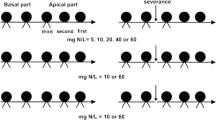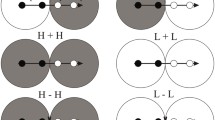Abstract
Individuals of clonal plants consist of physically and physiologically connected ramets. In splitters, they are integrated for a time shorter than ramet generation time (i.e. the time it takes to produce the first offspring ramet), whereas in integrators connections between ramets persist for a longer time. It has been predicted that integrators should prevail in stressful environments, such as habitats poor in nutrients, whereas splitters are expected to dominate in benign habitats, such as fertile areas with a moderate climate. I tested these predictions in four dry mountain areas of the Trans-Himalaya, in high altitudes subjected to multiple stresses. In accordance with the expectations I found that clonal plants with integrated ramets reach higher mean and maximum altitudes than splitters. Integrators were over-represented in nutrient-poor habitats, such as dry semi-deserts, sandy steppes and in subnival habitats, whereas splitters preferentially colonised mesic habitats, saline sites and wetlands. While there was no difference in the representation of splitters and integrators in habitats with an unstable surface, such as screes, dunes and water bodies, fully integrated clonal plants preferred very stable environments, such as banks of streams covered by closed-canopy vegetation. Most relationships between clonal integration and environmental factors were explainable by the phylogenetic relationship between the species, only the significant preference of splitters for shaded environments persisted in phylogenetically corrected analysis. The results indicate that clonal integration belongs to a set of evolutionarily conservative plant traits, usually shared by related species. Consequently, the adaptive value of clonal integration in individual habitats remains questionable.



Similar content being viewed by others
References
Al-Shehbaz I, Beilstein MA, Kellogg EA (2006) Systematics and phylogeny of the Brassicaceae (Cruciferae): an overview. Pl Syst Evol 259:89–120
Bailey CD, Koch MA, Mayer M et al (2006) Toward a global phylogeny of the Brassicaceae. Mol Biol Evol 23:2142–2160
Bazilevich NI, Tishkov AA (1977) Live and dead reserves and primary production in polar desert, tundra and forest tundra of the former Soviet Union. Ecosystems of the world 3:509–539
Beilstein MA, Al-Shehbaz IA, Kellogg EA (2006) Brassicaceae phylogeny and trichome evolution. Am J Bot 93:607–619
Bellingham PJ, Sparrow AD (2000) Resprouting as a life history strategy in woody plant communities. Oikos 89:409–416
Bhattacharyya A (1989) Vegetation and climate during the last 30,000 years in Ladakh. Palaeogeogr Palaeoclimatol Palaeoecol 73:25–38
Briske DD, Derner JD (1998) Clonal biology of caespitose grasses. In: Cheplick GP (ed) Population biology of grasses. Cambridge University Press, Cambridge, pp 106–135
Callaghan TV, Jonasson S, Brooker RW (1997) Arctic clonal plants and global change. In: de Kroon H, van Groenendael J (eds) The ecology and evolution of clonal plants. Backhuys Publishers, Leiden, pp 381–403
Chen JS, Lei NF, Yu D et al (2006) Differential effects of clonal integration on performance in the stoloniferous herb Duchesnea indica, as growing at two sites with different altitude. Plant Ecol 183:147–156
Chen JS, Yu D, Liu Q et al (2004) Clonal integration of the stoloniferous herb Fragaria vesca from different altitudes in Southwest China. Flora 199:342–350
Chowdhery HJ, Rao RR (1990) Plant life in the Himalayan cold deserts: some adaptive strategies. Bull Bot Surv India 32:43–56
de Kroon H, van Groenendael JM (eds) (1997) The ecology and evolution of clonal plants. SPB Academic Publishing, The Hague
D’Hertefeldt T, Falkengren-Grerup U (2002) Extensive physiological integration in Carex arenaria and Carex disticha in relation to potassium and water availability. New Phytol 156:469–477
Dickoré WB (1995) Systematische Revision und chorologische Analyse der Monocotyledoneae des Karakorum (Zentralasien, West-Tibet). Flora Karakorumensis I. Angiospermae, Monocotyledoneae. Stapfia 39. Botanische Arbeitsgemeinschaft am ÖO Landesmuseum, Linz
Dickoré WB, Miehe G (2002) Cold spots in the highest mountains of the world—diversity patterns and gradients in the flora of the Karakorum. In: Körner C, Spehn E (eds) Mountain Biodiversity: a global assessment. Parthenon Publishers, Lancaster, pp 129–147
Durka W (2002) Phylogenie der Farn- und Blütenpflanzen Deutschlands. Schriftenreihe Vegetationskunde 38:75–91
Ellenberg H (1991) Indicator values for plants in central Europe. Scripta Geobot 18:1–248
Fischer M, van Kleunen M (2001) On the evolution of clonal plant life histories. Evol Ecol 15:565–582
Fox JL, Nurbu C, Chundawat RS (1991) The mountain ungulates of Ladakh, India. Biol Conserv 58:167–190
Funk VA, Bayer RJ, Keeley S et al (2005) Everywhere but Antarctica: using a supertree to understand the diversity and distribution of the Compositae. Biol Skr 55:343–374
Halassy M, Campetella G, Canullo R et al (2005) Patterns of functional clonal traits and clonal growth modes in contrasting grasslands in the central Apennines, Italy. J Veg Sci 16:29–36
Hartmann H (1983) Pflanzengesellschaften entlang der Kashmirroute in Ladakh. Jahrb Ver Schutz Bergwelt 48:131–173
Hartmann H (1984) Neue und wenig bekannte Blütenpflanzen aus Ladakh mit einem Nachtrag zur Flora des Karakorum. Candollea 39:507–537
Hartmann H (1987) Pflanzengesellschaften trockener Standorte aus der subalpinen und alpinen Stufe im südlichen und östlichen Ladakh. Candollea 42:277–326
Hartmann H (1990) Pflanzengesellschaften aus der alpinen Stufe des westlichen, südlichen und östlichen Ladakh mit besonderer Berücksichtigung der rasenbildenden Gesellschaften. Candollea 45:525–574
Hartmann H (1995) Beitrag zur Kenntnis der subalpinen Wüsten-Vegetation im Einzugsgebiet des Indus von Ladakh (Indien). Candollea 50:367–410
Hartmann H (1997) Zur Flora und Vegetation der Halbwüsten, Steppen und Rasengesellschaften im südöstlichen Ladakh (Indien). Jahrb Ver Schutz Bergwelt 62:129–188
Hartmann H (1999) Studien zur Flora und Vegetation im östlichen Transhimalaya von Ladakh (Indien). Candollea 45:171–230
Harvey PH, Pagel M (1991) The evolutionary method in comparative biology. Oxford University Press, Oxford
Holmgren PK, Holmgren NH, Barnett LC (1990) Index Herbariorum Part I. The herbaria of the world. Regnum Veg. 120, Koeltz Scientific Books, Koenigstein
Holzner W, Kriechbaum M (1998) Man’s impact on the vegetation and landscape in the Inner Himalaya and Tibet. In: Elvin M, Ts’ui-Jung L (eds) Sediments of time. Environment and society in Chinese history. Cambridge University Press, Cambridge, pp 53–106
Hutchings MJ, de Kroon H (1994) Foraging in plants: the role of morphological plasticity in resource acquisition. Adv Ecol Res 25:159–238
Jacquemyn H, Brys R, Honnay O et al (2005) Local forest environment largely affects below-ground growth, clonal diversity and fine-scale spatial genetic structure in the temperate deciduous forest herb Paris quadrifolia. Mol Ecol 14:4479–4488
Jina PS (1995) High pasturelands of Ladakh Himalaya. Indus Publishing Company, New Delhi
Jonasson S, Callaghan TV (1992) Root mechanical-properties related to disturbed and stressed habitats in the arctic. New Phytol 122:179–186
Jónsdóttir IS, Watson MA (1997) Extensive physiological integration: an adaptive trait in resource-poor environments? In: de Kroon H, van Groenendael J (eds) Ecology and evolution of clonal plants. Backhuys Publishers, Leiden, pp 109–136
Kadereit G, Borsch T, Weising K et al (2003) Phylogeny of Amaranthaceae and Chenopodiaceae and the evolution of C4 photosynthesis. Int J Plant Sci 164:959–986
Kadereit G, Hohmann S, Kadereit JW (2006) A synopsis of Chenopodiaceae subfam. Betoideae and notes on the taxonomy of Beta. Willdenowia 36:9–19
Kala CP, Mathur VB (2002) Patterns of plant species distribution in the Trans-Himalayan region of Ladakh, India. J Veg Sci 13:751–754
Kapadia H (1999) Across peaks & passes in Ladakh, Zanskar & East Karakoram. Indus Publishing Company, New Delhi
Kita Y, Fujikawa K, Ito M et al (2004) Molecular phylogenetic analyses and systematics of the genus Saussurea and related genera (Asteraceae, Cardueae). Taxon 53:679–690
Klimeš L (2003) Life-forms and clonality of vascular plants along an altitudinal gradient in E Ladakh (NW Himalayas). Basic Appl Ecol 4:317–328
Klimeš L, Klimešová J, Hendriks R et al (1997) Clonal plant architectures: a comparative analysis of form and function. In: de Kroon H, van Groenendael J (eds) The ecology and evolution of clonal plants. Backhuys Publishers, Leiden, pp 1–29
Klimešová J, Klimeš L (2003) Resprouting of herbs in disturbed habitats: is it adequately described by the Bellingham–Sparrow’s model? Oikos 103:225–229
Klimešová J, Klimeš L (2007) Bud bank and its role in vegetative regeneration. review of literature and proposal of classification and easy assessment. Persp Pl Ecol Evol Syst 8:115–129
Körner Ch (1999) Alpine plants: stressed or adapted? In: Press MC, Scholes JD, Barker MG (eds) Physiological plant ecology. Blackwell, Oxford, pp 297–311
Lampe von M (1999) Vorschlag zur Bezeichnung der Innovations- und Überdauerungsorgane bei den terrestrischen Stauden Zentraleuropas. Biol Beitr Pfl 71:335–367
Magori K, Oborny B, Dieckmann U et al (2003) Cooperation and competition in heterogeneous environments: the evolution of resource sharing in clonal plants. Evol Ecol Res 5:787–817
Mallon DP (1991) Status and conservation of large mammals in Ladakh. Biol Conserv 56:101–119
Miehe G, Winiger M, Böhner J, Zhang Yili (2001) The climatic diagram map of High Asia. Purpose and concepts. Erdkunde 55:94–97
Müller K, Borsh T (2005) Phylogenetics of Amaranthaceae based on matK/trnK sequence data—evidence from parsimony, likelihood, and Bayesian analyses. Ann Miss Bot Gard 92:66–102
Oborny B, Kun A, Czaran T et al (2000) The effect of clonal integration on plant competition for mosaic habitat space. Ecology 81:3291–3304
O’Kane SL, Al-Shehbaz IA (2003) Phylogenetic position and generic limits of Arabidopsis (Brassicaceae) based on sequences of nuclear ribosomal DNA. Ann Miss Bot Gard 90:603–612
Pitelka LF, Ashmun JW (1985) Physiology and integration of ramets in clonal plants. In: Jackson JBC, Buss LW, Cook RE (eds) Population biology and evolution of clonal organismus. Yale University, Yale, pp 399–435
Purvis A (1991) Comparative Analysis by Independent Contrasts (C.A.I.C). A statistical package for the Apple Macintosh. Version 1.2, User’s Guide. Department of Zoology, University of Oxford, Oxford, p 40
Purvis A, Rambaut A (1995) Comparative analysis by independent contrasts (CAIC), an Apple Macintosh application for analysing comparative data. Comp Appl Biosci 11:247–251
Rawat GS, Adhikari BS (2005) Floristics and distribution of plant communities across moisture and topographic gradients in Tso Kar basin, Changthang plateau, eastern Ladakh. Arct Antarct Alp Res 37:539–544
Ricklefs RE (1996) Applications of phylogenetically independent contrasts: a mixed progress report. Oikos 77:167–172
Soltis DE, Soltis PS, Endress PK et al (2005) Phylogeny and evolution of Angiosperms. Sinauer, Sunderland
van Groenendael JM, Klimeš L, Klimešová J et al (1996) Comparative ecology of clonal plants. Phil Trans R Soc Lond B351:1331–1339
Warwick SI, Al-Shehbaz IA, Price RA et al (2002) Phylogeny of Sisymbrium (Brassicaceae) based on ITS sequences of nuclear ribosomal DNA. Can J Bot 80:1002–1017
Warwick SI, Al-Shehbaz IA, Sauder CA (2006) Phylogenetic position of Arabis arenicola and generic limits of Aphragmus and Eutrema (Brassicaceae) based on sequences of nuclear ribosomal DNA. Can J Bot 84:269–281
Warwick SI, Al-Shehbaz IA, Sauder CA et al (2004a) Phylogeny of Smelowskia and related genera (Brassicaceae) based on nuclear its DNA and chloroplast trnL intron DNA sequences. Ann Miss Bot Gard 91:99–123
Warwick SI, Al-Shehbaz IA, Sauder C et al (2004b) Phylogeny of Braya and Neotorularia (Brassicaceae) based on nuclear ribosomal internal transcribed spacer and chloroplast trnL intron sequences. Can J Bot 82:376–392
Wilhalm T (1995) A comparative study of clonal fragmentation in tussock-forming grasses. Abstr Bot 19:51–60
Wojciechowski MF, Lavin M, Sanderson MJ (2004) A phylogeny of legumes (Leguminosae) based on analysis of the plastid matK gene resolves many well-supported subclades within the family. Am J Bot 91:1846–1862
Yue JP, Sun H, Al-Shehbaz IA, Li JH (2006) Support for an expanded Solms-Laubachia (Brassicaceae): evidence from sequences of chloroplast and nuclear genes. Ann Miss Bot Gard 93:402–411
Zotz G, Cueni N, Körner C (2006) In situ growth stimulation of a temperate zone liana (Hedera helix) in elevated CO2. Funct Ecol 20:763–769
Acknowledgments
Jitka Klimešová made useful comments on a draft of this paper, Jan W. Jongepier improved my English. The work was financially supported by project no. 206/03/1219 of the Grant Agency of the Czech Republic.
Author information
Authors and Affiliations
Corresponding author
Rights and permissions
About this article
Cite this article
Klimeš, L. Clonal splitters and integrators in harsh environments of the Trans-Himalaya. Evol Ecol 22, 351–367 (2008). https://doi.org/10.1007/s10682-007-9195-3
Received:
Accepted:
Published:
Issue Date:
DOI: https://doi.org/10.1007/s10682-007-9195-3




